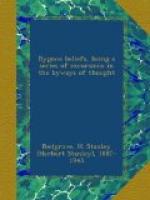[1] “The reverence as well as the worship paid to the phallus, in early and primitive days, had nothing in it which partook of indecency; all ideas connected with it were of a reverential and religious kind....
“The indecent ideas attached to the representation of the phallus were, though it seems a paradox to say so, the results of a more advanced civilization verging towards its decline, as we have evidence at Rome and Pompeii....
“To the primitive man [the reproductive force which pervades all nature] was the most mysterious of all manifestations. The visible physical powers of nature—the sun, the sky, the storm—naturally claimed his reverence, but to him the generative power was the most mysterious of all powers. In the vegetable world, the live seed placed in the ground, and hence germinating, sprouting up, and becoming a beautiful and umbrageous tree, was a mystery. In the animal world, as the cause of all life, by which all beings came into existence, this power was a mystery. In the view of primitive man generation was the action of the Deity itself. It was the mode in which He brought all things into existence, the sun, the moon, the stars, the world, man were generated by Him. To the productive power man was deeply indebted, for to it he owed the harvests and the flocks which supported his life; hence it naturally became an object of reverence and worship.
“Primitive man wants some object to worship, for an abstract idea is beyond his comprehension, hence a visible representation of the generative Deity was made, with the organs contributing to generation most prominent, and hence the organ itself became a symbol of the power.”—H, M. WESTROPP: Primitive Symbolism as Illustrated in Phallic Worship, or the Reproductive Principle (1885), pp. 47, 48, and 57. {End of long footnote}
The Aruntas of Australia, I believe, when discovered by Europeans, had not yet observed the connection between sexual intercourse and birth. They believed that conception was occasioned by the woman passing near a churinga—a peculiarly shaped piece of wood or stone, in which a spirit-child was concealed, which entered into her. But archaeological research having established the fact that phallicism has, at one time or another, been common to nearly all races, it seems probable that the Arunta tribe represents a deviation from the normal line of mental evolution. At any rate, an isolated phenomenon, such as this, cannot be held to controvert the view that regards phallicism as in this normal line. Nor was the attitude of mind that not only accepts sex at face-value as an obvious fact, but uses the concept of it to explain other facts, a merely transitory one. We may, indeed, not difficultly trace it throughout the history of alchemy, giving rise to what I may term “The Phallic Element in Alchemical Doctrine”.




